Ecommerce Strategy for Sports & Health Shopify Stores
Online sports and health stores are seeing success like never before. In fact, the sports and wellness sector is currently one of the fastest growing in the USA; earning $63 billion in sales each year. As these statistics show, there is certainly no lack of demand for sports, health and wellness products. However, there is also no shortage of competition for the businesses supplying them. So how do you go about making a name for yourself when starting up in this rapidly expanding industry?
Written By
Esther Lowde
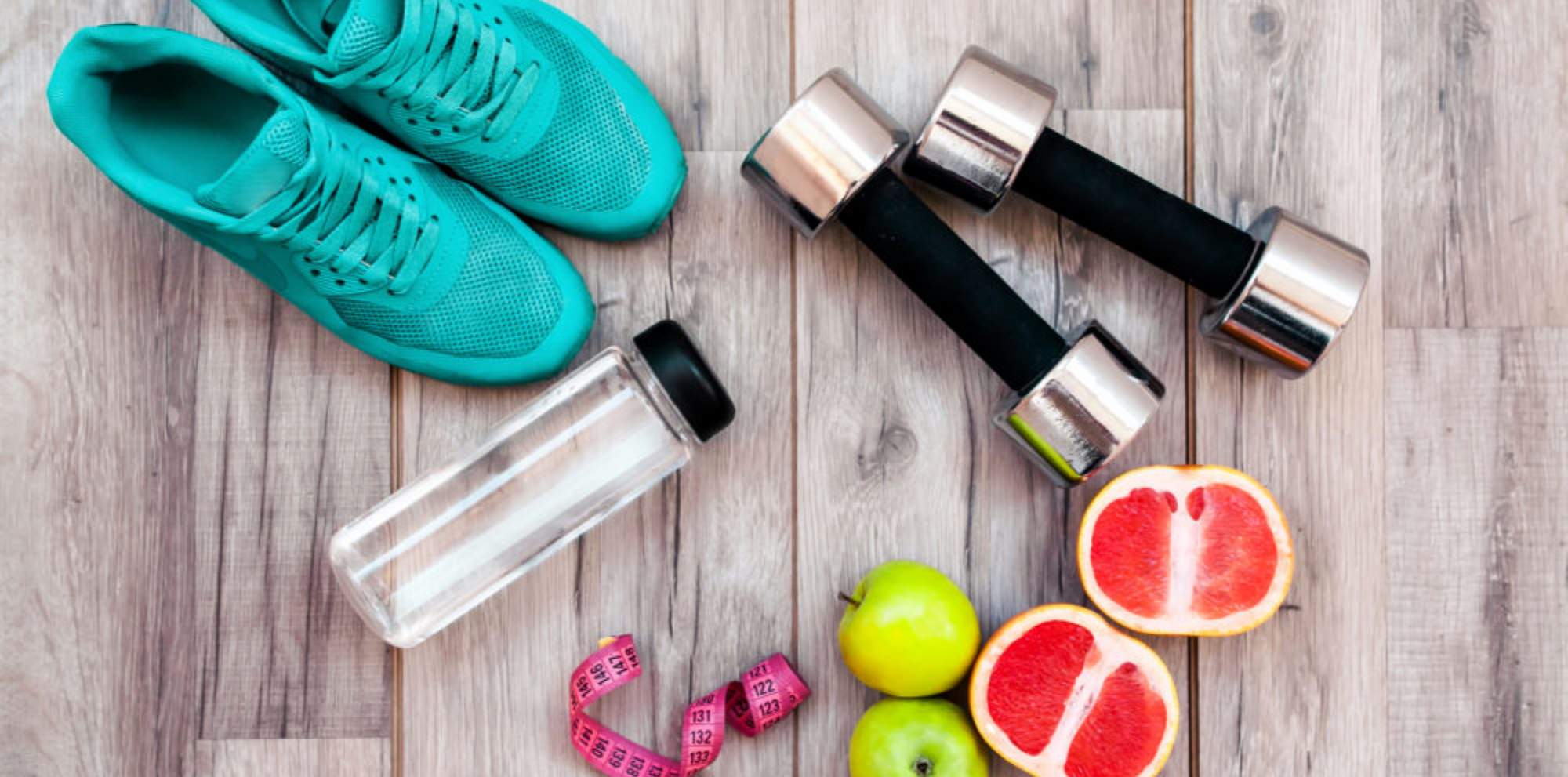
With the recent surge in the popularity of health supplements, equipment, foods and attractive sportswear, the options available to individuals searching for sports, health and outdoor products online are almost limitless.
Finding ways to engage potential customers is therefore no longer an option but a necessity.
To help get you started, we’ve put together our top 10 tips for creating the best growth strategy possible for your Shopify store:
1. Decide whether your products are going to follow the trends or create them
Begin by deciding on your store’s unique position in the sports and health segment. Are you going to try creating something new and ground-breaking, or fit in with what’s fashionable in the sector right now? Are there any gaps in the market that you feel your brand could fill?
Following the latest trends of the industry is a good way to guarantee that there will be a large segment of customers interested in the products you’ll be selling.
For example, Zobha are one brand who have achieved great ecommerce success by providing trendy women’s workout and athleisure clothing that is extremely comparable in fit, colour and style to the likes of leading women’s athleisure brand Lulu Lemon.
However, if you do take this approach, you’re going to have to compete on price in order to stand out. This is exactly what Zobha have done to maximise their sales, with their own workout clothing retailing for around half of the price of Lulu Lemon’s premium activewear; instantly making their products appealing to admirers of the Lulu Lemon look who can’t quite afford the brand’s hefty price tag.
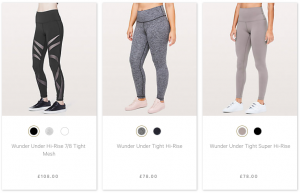
Leggings listed on a Lulu Lemon collection page.
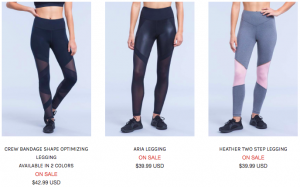
Similar legging designs advertised on Zobha at a significantly lower price.
On the other hand, if you have an idea for a sports and health product range that is completely unique, then you’re in unchartered territory and won’t have to worry as much about offering cheaper alternatives to other sports and health brands.
For example, global activewear brand Under Armour recently made headlines for its revolutionary athlete recovery sleepwear, which includes innovative products such as heat-reducing ‘Iso-Chill’ underwear and ‘CoolSwitch’ athletic gloves.
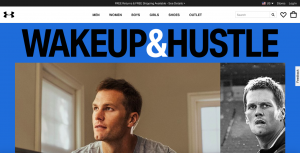
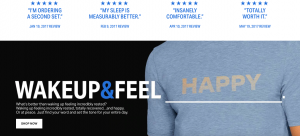
Screenshots from Under Armour’s new recovery sleepwear collection page.
Their exclusive new range of recovery sleepwear is costly (but still proving popular), with their men’s recovery pyjama range costing between $180-200 for a full top and bottom set.
Under Armour are able to charge high prices for this range of clothing not simply because they are already an internationally-recognised brand but also because they are one of – if not the only – sports and health brand to be selling these inventive sleepwear designs.
So, whether you have a revolutionary sports and fitness product you’re excited to get onto the virtual shelves or are mainly looking to recreate the trends you love seeing in popular stores, either approach can be hugely successful – provided you are marketing to the right audience in the right way.
2. Find creative ways to appeal to your target customers
Once you’ve established the kind of products you are going to be selling, you’ll need to do some thorough research into who your target audience will be and the most effective way of attracting them to your store.
This will include carrying out research regarding what your competitors are doing and investigating the interests of your target customer base, including doing some research into the specific keywords and phrases that they are searching for on Google.
An effective way of gaining and utilising data-driven customer insight simultaneously is through personalising your store’s content. One way this can be done is through integrating online customer surveys and questionnaires into your store.
For example, one sports brand which offers its customers a personalised shopping experience is Fabletics; an athleisure clothing store which suggests clothing items to online shoppers based on their lifestyle and fashion preferences.
Before browsing the store’s collection pages, visitors to the website are asked multiple-choice questions about their daily workout activities, sizing and style.
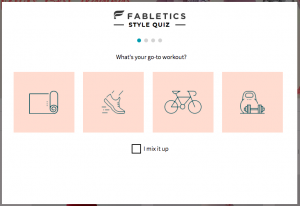
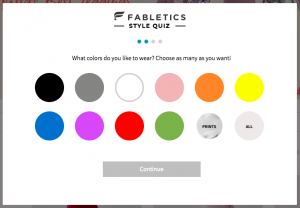
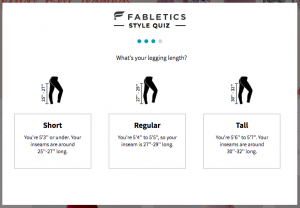
Examples of pop-up questions as part of Fabletics’ Style Quiz.
This survey approach is a great way of getting to know your target audience as the more you exercise data-driven customer insights in this way, the more you will learn about your buyers’ preferences and the more efficiently you can market to them in future.
This learning process can also continue in other ways on your store by using heatmapping technology (such as HotJar) and Google Analytics data to create a customer profile (based on your customers’ typical gender, age range, interests and local area).
We would also recommend looking into which social media channels are generating your highest-spending traffic and identifying which of your marketing efforts are attracting the most traffic to your website.
One brilliant tool for capturing and understanding this data – and then using it to present your audiences with personalised content – is Dynamic Yield.
After capturing all of this information, you will be able to develop a growth strategy that allows you to reach out to the right group of people in the right way on their preferred channels – meaning more relevant product recommendations for them and more traffic, sales and revenue for you.
For example, in order to further appeal to their ideal customer pool – let’s say, young women looking for affordable and feminine activewear – Fabletics also claim to be ‘all inclusive’ and offer their customers a wider range of sizing than they may find at other women’s activewear stores.
Companies selling inspired goods in an already-crowded market can therefore compete with the big brands by finding out what their customers are looking for and offering them more flexibility in sizing or price.
These techniques have clearly had a powerful impact on Fabletics’ success, as the athleisure brand has been experiencing a revenue increase of 35% every year since its launch in 2013. Why not try something similar on your store and experience similarly positive results?
3. Get your imagery right
When it comes to selling sports and health products, your imagery needs to be sleek and strong at all times.
Placing emphasis on the details of your product itself is crucial, but you should also use your imagery to motivate potential customers to buy into the lifestyle that your sports or health product is designed to accompany.
On Fitbit’s website, for example, the leading fitness tracker wristband company use images of groups of people embarking on adventures and having active social experiences to create an air of excitement around their product and to encourage their fitness-loving users to become part of an exciting and dynamic movement.
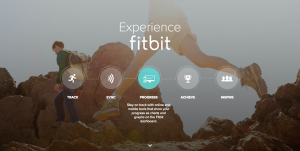
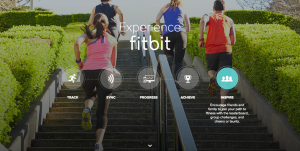
When using life shots to sell your products, however, it’s important not to let your products become overpowered by a busy background.
Use high-quality images of your products throughout your store to build customers’ trust in your website; allowing shoppers to see your products up close and in detail so it becomes immediately clear that what you’re selling is of a high quality and that you have nothing to hide.
For example, one of our previous Shopify Plus clients – meal replacement powder brand Huel – is selling its bars, powders and granola products exceptionally well through the use of strong product imagery.
Huel keep their background white and minimalist (to maintain their strong monochrome branding and keep the spotlight on their product images), use clear high-quality photos of the goods that they stock and – as their products are packaged consumables – showcase what their food looks like inside its wrapping in order to build trust among their consumers.
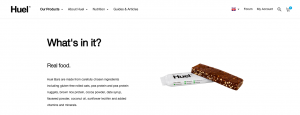
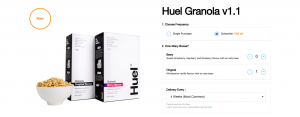
Huel’s high-resolution images of both the inside and outside of their products.
As the average online customer will form their first impression of your store within a mere 50 milliseconds (that’s less than half a glance!), showcasing honest pictures of your products in this way is crucial when it comes to persuading online shoppers to buy from your store.
However, the visual power of your website doesn’t have to be limited to simply the imagery that you use.
Perhaps even more than other industries, it’s important for those selling products in the sports and health sector to make use of on-site product videos in order to showcase the speed and movement of their products.
In fact, research shows that viewers are anywhere from 64-85% more likely to buy a product after watching a video of it first – making this a marketing move you’d be unwise to ignore.
4. Build relationships with sports and fitness influencers
In a visually-focussed industry that’s becoming more and more about ‘who’s got what’, reaching out to influencers with a large online following is a sure way of boosting your store’s credibility and sales while keeping your brand image relevant and on-trend.
In fact, studies show that 92% of consumers trust recommendations from others over branded content.
This means that if you have healthy, attractive, trusted role models recommending your products to their followers online, your target audience are much more likely to trust in your business as they will not only be more likely to believe your claims but will associate your brand with achieving positive results, reaching their fitness goals and becoming more like the people they admire.
One Shopify Plus enterprise who have used influencer marketing as a key part of their growth strategy are Gymshark, who sponsor a variety of fitness influencers to promote and model their active clothing lines.
Gymshark also sponsor Youtube and Instagram influencers to review and try on their clothing in informative videos for their viewers, reaching a wide audience of young people (all already interested in the fitness world) who are then sent straight to Gymshark’s website and encouraged to try out the activewear for themselves.
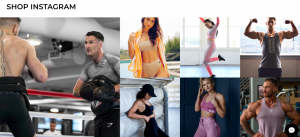
Social media influencers featured in a built-in shoppable Instagram feed on Gymshark’s homepage.
5. Feature user-generated content on your store
Featuring user-generated content on your Shopify store is a huge conversion-booster, with multiple studies demonstrating that displaying customer reviews on your website produces an 18% uplift in sales on average!
In a sector as competitive as sports and health, you really can’t afford not to be making the most of credibility-boosting opportunities such as this.
Perhaps one of the simplest – yet most effective – ways of incorporating user-generated content into your store is to allow your customers to leave reviews on your website.
We recommend Yotpo and Okendo as two of the best apps for integrating customer reviews into your website as they allow customers to rate different aspects of a product – such as the fit, style and quality of a clothing item – and also to upload photo and video reviews, which are even more attention-grabbing.
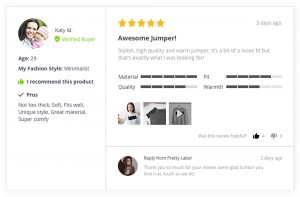
Example of a review left by an Okendo user, demonstrating customers’ ability to rate different aspects of a product.
This powerful user-generated content can also be used as a highly effective marketing tool when you share your happy customers’ reviews on your brand’s social media channels.
Further, you can use apps or plugins such as Walls to display customer-sourced social media photos of your products in action on your store. This is another great conversion-booster as 77% of customers state that they are more influenced by authentic customer-submitted photos when shopping than by professionally taken images.
For example, leading sports brand Nike feature a ‘how others are wearing it’ section on the majority of their product pages, and use this space to feature their happy buyers working out in their footwear and clothing range.
This is a great example of a brand engaging directly with their customer base and making the most of customer-sourced marketing material which – in addition to being completely free – is also more effective than professional product photography.
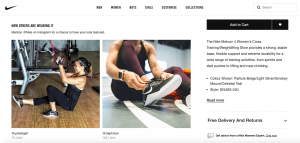
Customer-sourced Instagram content on a Nike product page.
6. Integrate a loyalty program into your Shopify store
With studies demonstrating that just a 5% increase in customer loyalty can increase the average profit per customer by 25-100%, loyalty programs are clearly an absolute must for increasing customer retention and lifetime value across all ecommerce sectors.
Loyalty programs give you the chance to build and nurture relationships with your customers; offering them exclusive perks and discount codes as a reward not just for their purchases but also for their continued loyalty, recommendations, product reviews and newsletter sign-ups. This is great for customer engagement, which increases new visitors’ trust in your brand.
At Swanky, we have worked with our technology partner LoyaltyLion on a range of different loyalty projects, all of which we are delighted to say have generated consistently impressive results for our Shopify clients.
For example, we were able to boost one Shopify Plus retailer’s revenue by 226% (!) through rejuvenating their customer rewards scheme and have helped other stores to up their number of returning customers significantly through a loyalty program launch.
To come back to an earlier example, athleisure company Fabletics offer their customers the chance to become a VIP member (and receive exclusive deals as a result) on their store’s homepage throughout their website.

Advertisement for Fabletics’ loyalty program on the store’s homepage, highlighting a significant perk of membership (2 leggings for $24 instead of $99).
Offering exclusive deals like this is a great way of enticing your customers to come back for more; increasing your customer retention, happiness and overall lifetime value.
7. Consider offering your customers a subscription service
According to Growth Business, an estimated 58 million adults in Britain are now subscribed to their favourite stores, brands and services. That’s 90% of the adult British population!
But why have subscription services recently become so popular with both customers and businesses alike?
Much like launching a loyalty program, the subscription business model is a perfect opportunity for you to nurture your relationship with your customers, increase their lifetime value and reward them for their loyalty to your brand.
This can be done by offering ‘subscribe and save’ product discounts to reward regular buyers for their continued support and incentivise them to remain subscribed to you; meaning both you and your customers benefit hugely from the service.
Within the sports and health sector, the subscription business model is especially well-suited to companies selling consumable fitness supplements and health foods (which customers will frequently run out of and will need to keep repurchasing).
If this sounds like you, it may be well worth considering setting up your own subscription service as soon as possible to reap all the benefits of increased customer happiness, lifetime value and retention.
You could also consider offering complementary workout plans in your subscription boxes to give customers an extra incentive to subscribe!
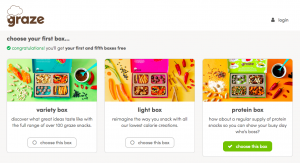
Leading healthy snack brand Graze’s own subscription box page.
8. Reach out to your industry network and community
When it comes to building brand awareness, getting involved in your local community is always a good idea.
As a sports and health business, contacting gyms and other fitness communities in your local area is an obvious place to start. Do your research into nearby fitness centres and don’t shy away from getting in touch with them and asking about the possibility of collaborating on a project or event.
For example, is there going to be a health food or fitness clothing exposition at a fitness centre in your area this year that you could get involved with? Or would any of your local gyms be interested in buying your sports or health products at a discounted rate for their members?

Beyond this, collaborating with local charities is a fantastic way of building rapport with your customers.
This is because, from an ethical standpoint, consumers today expect more from the companies that they buy from. Specifically, customers looking to invest in their health and fitness likely also value the health of their society and planet. This new generation of consumers want their purchases to have a positive impact on the world – and they won’t hesitate to reward brands that do.
For example, Nike engages in several community outreach initiatives around the world, and their community store program aims to serve the city through volunteer work and promoting physical fitness.
When the brand opened their 7th community store in Detroit, the initiative was met with huge public approval and countless new buyers interested in purchasing from Nike’s new range – with customers even queuing up 2 days before the store’s launch!

Nike’s Community Impact website.
Consider the opportunities you have in your own city or local area to bring about positive change while also promoting your brand and reaching as many of your target customers as possible.
For example, could you organise a race or similar sporting event to raise money for a local charity? Or offer to provide all of the prizes for an existing sports-related charity event?
These types of opportunities are all linked to your store’s digital growth strategy as sharing these uplifting and exciting events on your brand’s social channels – and subsequently having your posts shared by all those involved – will help raise brand awareness, customer trust and ultimately bring more interested traffic to your ecommerce store.
Building links from other websites is also a fantastic way to increase your store’s SEO, upping both you and your collaborators’ search ranking on Google.
9. Host competitions and giveaways on your store
Aside from organising physical pop-ups and community events, you can create a buzz around your store online by incentivising potential customers to enter into friendly social media contests for a chance to win a prize from your health or fitness range.
This can lead to users sharing posts with friends that feature your brand name or products. It’s essentially free advertising; upping your brand visibility and ensuring that you reach new individuals within your target audience.
Get creative with the topic of your competition and think about the type of contest that will likely engage your customer demographic best. Would they be interested in picking out the next flavour for your new protein powder range? Or maybe they’d like a chance to post a picture of themselves taking part in a particular upcoming charity run?
Whatever you decide would engage your consumers best, don’t miss the opportunity to interact with them directly and reach other similar consumers in the process.
You could even display your contestants’ hashtagged Instagram or Twitter entries on your store’s homepage – using an integrated social feed – for an extremely effective on-site marketing tool.
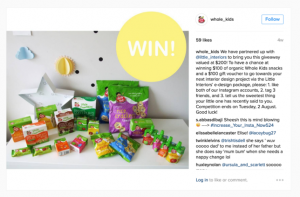
Healthy children’s snacks brand Whole Kids teamed up with children’s room design company The Little Interior to create a mutually beneficial competition for their followers. The contest encouraged users to interact with their social media accounts and tag their friends in their entries for a chance to win a bundle of healthy Whole Kids snacks and a $100 gift voucher.
10. Sell a lifestyle; not just a product
Creating an emotional connection with your customers is the secret to a powerful marketing strategy.
Particularly in the sports and health sector, where the focus of many products is to help customers live more energetically and feel better in their own skin, there is huge opportunity for reaching your buyers on a more meaningful level.
In all of your future marketing initiatives and growth plans, remember that you’re not just trying to sell your customers a nice pair of trainers or a tasty protein bar; you’re providing them with the key to a new and improved lifestyle where they can aspire to be the healthiest, happiest version of themselves.
For example, if we take a look at some of the most successful brands in this industry, they frequently broadcast bold and empowering messages which aim to inspire and motivate their customers to feel powerful emotions such as determination, confidence and self-love.


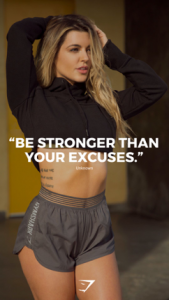
Examples of motivational adverts by Nike, Adidas and Gymshark.
This is called emotional branding and has been proven to sway buyers into making a purchase decision as it taps into instinctive emotional responses and makes consumers feel empowered, motivated, optimistic and capable – emotions which they then subconsciously associate with a particular brand and their products.
So, while you’re deliberating how best to advertise your fitness and health product ranges, remember the importance of not simply telling your audience how good your products are but connecting with them on an emotional level.
This can be a crucial part of planting the seed for a relationship with your customers which will last for a long time; keeping your buyers satisfied and your business thriving.
Now you can ‘just do it’!
After you’ve identified your store’s unique approach, pinpointed your target audience and thought about how best you can appeal to your ideal customer pool, you’re well on your way to achieving your full potential in one of the most saturated but exciting and fast-paced ecommerce industries around.
However, it’s important to remember that when it comes to developing a strong digital strategy for your sports and health store, there is no finish line.
Instead, your growth strategy is a continual and looping process. The more you engage with and gain insight from your customers, the better you will be able to market to them specifically, making your growth strategy a continuous strive for improvement – and meaning there are no limits to the success your Shopify store could achieve.
Looking to outsource your digital marketing strategy and/or management? If so, please feel free to get in touch with our friendly team of digital experts at Swanky for a chat about how we could help your online sports and health store increase its traffic, sales and revenue.

